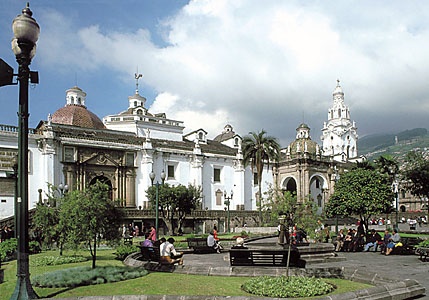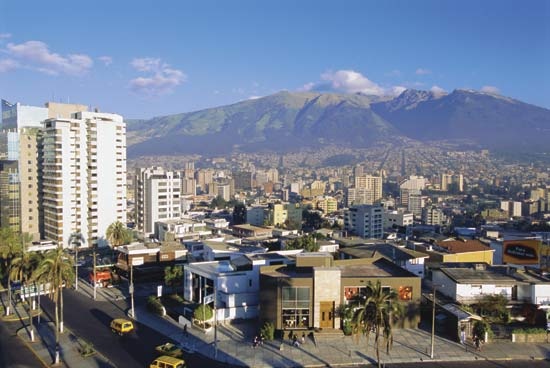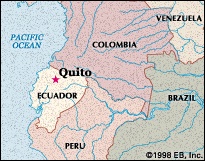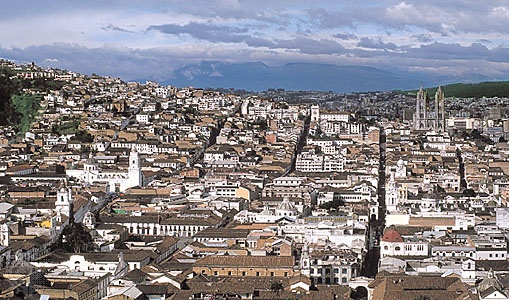Quito
Ecuador
in full Villa de San Francisco de Quito



city and capital of Ecuador. It is situated on the lower slopes of the volcano Pichincha, which last erupted in 1666, in a narrow Andean (Andes Mountains) valley at an elevation of 9,350 feet (2,850 metres), just south of the Equator. The oldest of all South American capitals, Quito is notable for its well-preserved old town, which was designated a UNESCO World Heritage site in 1978.
The area was a market centre and political frontier before its conquest by the Inca empire (pre-Columbian civilizations), which led to its fortification as an Inca settlement. Sebastián de Belalcázar (Benalcázar, Sebastián de), a lieutenant of the Spanish conquistador Francisco Pizarro (Pizarro, Francisco), occupied the city on Dec. 6, 1534, and declared a municipal government (cabildo). (Founder's Day, December 6, is marked with a weeklong celebration.) Quito remained the focal point of national affairs—political, social, and economic—until the early 20th century, when economic dominance shifted to Guayaquil. A distinct rivalry between the two cities still exists, with Quito remaining the country's political and cultural centre.
 Quito preserves much of its colonial atmosphere, with the towers of many churches outlined against the circle of volcanoes that surrounds the Quito Basin and with peaceful squares, fountains, balconied houses, steep narrow streets, iron-grilled doorways, and secluded gardens. Unlike other Latin American cities, where sprawling yet impoverished suburbs ring the core districts, a large proportion of Quito's poverty-fringe population lives in central city slums.
Quito preserves much of its colonial atmosphere, with the towers of many churches outlined against the circle of volcanoes that surrounds the Quito Basin and with peaceful squares, fountains, balconied houses, steep narrow streets, iron-grilled doorways, and secluded gardens. Unlike other Latin American cities, where sprawling yet impoverished suburbs ring the core districts, a large proportion of Quito's poverty-fringe population lives in central city slums.In 1552 an art school was established in Quito, one of the first of its kind in South America. This marked the foundation of a religious art movement that flourished throughout the Spanish colonial period, leaving a wealth of wooden polychrome sculpture and paintings unsurpassed in the New World. Many of Quito's churches, cloisters, and old mansions are veritable museums. Among the most admired of Quiteño churches and convents are La Compañía (Jesuit), with Baroque columns, ceilings, and massive altars covered with gold leaf; San Francisco, with its magnificent cloister; Carmen Alto, home of the native Santa Mariana de Jesús; San Agustín, where Ecuador's Act of Independence was signed in 1809; Santo Domingo, noted for its handsome altar and facade; the Sagrario; and the 16th- to 17th-century cathedral, burial place of the hero of independence, Antonio José de Sucre (Sucre, Antonio José de). At one time, religious buildings and lands occupied one-fourth of the city space. The gravest threat to colonial-era buildings in the city has been earthquakes, such as those of 1660, 1797, 1868, and (less severe) 1987.
 The Central University (government-sponsored) dates from 1586, the National Polytechnic School from 1869, and the Pontifical Catholic University of Ecuador from 1946 (raised to pontifical status in 1963). The Casa de la Cultura (Cultural Institute) includes museums of art and a library. Also notable are the Museum of Archaeology and Ethnology (1950), the Anthropology Museum (1925), the Municipal Museum of Art and History (1930), and the cultural museum (1969) of the Central Bank. Gracing Alameda Park is the astronomical observatory (1864), with its five small, elegant white towers.
The Central University (government-sponsored) dates from 1586, the National Polytechnic School from 1869, and the Pontifical Catholic University of Ecuador from 1946 (raised to pontifical status in 1963). The Casa de la Cultura (Cultural Institute) includes museums of art and a library. Also notable are the Museum of Archaeology and Ethnology (1950), the Anthropology Museum (1925), the Municipal Museum of Art and History (1930), and the cultural museum (1969) of the Central Bank. Gracing Alameda Park is the astronomical observatory (1864), with its five small, elegant white towers.Long an isolated highland centre, Quito was linked to the coast by the Guayaquil-Quito railway in 1908. The city has an international airport and lies on the Pan-American Highway. One of Ecuador's two major industrial centres (the other being Guayaquil), Quito produces textiles, pharmaceuticals, light consumer goods, and crafted objects of leather, wood, gold, and silver. The Trans-Ecuadorian Pipeline from the eastern oil fields in Napo province runs through Quito to Esmeraldas; another oil pipeline connects Quito with Guayaquil to the southwest. During the latter part of the 20th century, the city's commercial centre shifted northward with the construction of new banks, retail stores, and corporate offices, but the old town districts remain economically important.
The weekly outdoor Indian markets, or fairs, and small shops selling native crafts are among the characteristic sights of Quito. One of the best panoramic views of the city is from the Virgin of Quito landmark atop the hill called El Panecillo (“The Little Loaf of Bread”). Pop. (2003 est.) 1,482,447.
- Babia, Mount
- Babington, Anthony
- babirusa
- Babits, Mihály
- baboon
- Babrak Karmal
- Babrius
- Babson College
- Baburen, Dirck van
- Babuyan Islands
- Baby Dodds
- Baby Face Nelson
- Babylon
- Babylonia
- Babylonian calendar
- Babylonian Exile
- Babylonian Talmud
- baby's breath
- Baby Yar
- Bacab
- Bacall, Lauren
- Bacan
- baccarat
- Baccarat glass
- Bacchanalia